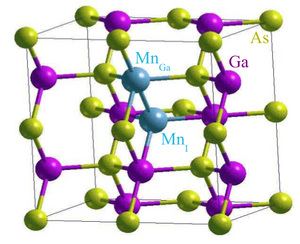Semiconductor Magnetism: Difference between revisions
| Line 1: | Line 1: | ||
== Diluted magnetic semiconductors == | == Diluted magnetic semiconductors == | ||
This family of materials encompasses standard semiconductors, in which a sizable portion of atoms is substituted by such elements, which produce localized magnetic moments in the semiconductor matrix. Usually, magnetic moments originate from 3d or 4f open shells of transition metals or rare earths (lanthanides), respectively, so that typical examples of diluted magnetic semiconductors (DMS) are Cd1-xCoxSe, Ga1-xMnxAs, Pb1-xEuxTe and, in a sense, Si:Er. A strong spin-dependent coupling between the band and localized states accounts for outstanding properties of DMS. This coupling gives rise to spin-disorder scattering, giant spin-splittings of the electronic states, formation of magnetic polarons, and strong indirect exchange interactions between the magnetic moments, the latter leading to collective spin-glass, antiferromagnetic or ferromagnetic spin ordering. Owing to the possibility of controlling and probing magnetic properties by the electronic subsystem or vice versa, DMS have successfully been employed to address a number of important questions concerning the nature of various spin effects in various environments and at various length and time scales. At the same time, DMS exhibit a strong sensitivity to the magnetic field and temperature as well as constitute important media for generation of spin currents and for manipulation of localized or itinerant spins by, e.g., strain, light. Electrostatic or ferromagnetic gates. These properties, complimentary to both non-magnetic semiconductors and magnetic metals, open doors for application of DMS as functional materials in spintronic devices. | |||
== magnetic impurities in semiconductors == | == magnetic impurities in semiconductors == | ||
Revision as of 13:11, 1 December 2010
Diluted magnetic semiconductors
This family of materials encompasses standard semiconductors, in which a sizable portion of atoms is substituted by such elements, which produce localized magnetic moments in the semiconductor matrix. Usually, magnetic moments originate from 3d or 4f open shells of transition metals or rare earths (lanthanides), respectively, so that typical examples of diluted magnetic semiconductors (DMS) are Cd1-xCoxSe, Ga1-xMnxAs, Pb1-xEuxTe and, in a sense, Si:Er. A strong spin-dependent coupling between the band and localized states accounts for outstanding properties of DMS. This coupling gives rise to spin-disorder scattering, giant spin-splittings of the electronic states, formation of magnetic polarons, and strong indirect exchange interactions between the magnetic moments, the latter leading to collective spin-glass, antiferromagnetic or ferromagnetic spin ordering. Owing to the possibility of controlling and probing magnetic properties by the electronic subsystem or vice versa, DMS have successfully been employed to address a number of important questions concerning the nature of various spin effects in various environments and at various length and time scales. At the same time, DMS exhibit a strong sensitivity to the magnetic field and temperature as well as constitute important media for generation of spin currents and for manipulation of localized or itinerant spins by, e.g., strain, light. Electrostatic or ferromagnetic gates. These properties, complimentary to both non-magnetic semiconductors and magnetic metals, open doors for application of DMS as functional materials in spintronic devices.
magnetic impurities in semiconductors
we can describe the DMS according to the model in which the electron states can divided in to two categories:
(i) localized magnetic d or f shells (ii) extended band states built up of s, p, and some times d atomic orbitals
The starting point for developing a useful predictive model of (III-Mn)V ferromagnetism is understanding of the electronic state with the single Mn impurity in the host lattice. we need to understand the charecter of Mn local moments before we explein how these isolated local moments are coupled. Ao we discuss the property of Mn impurity in GaAs and on the nature of ferromagnetic coupling in (Ga, Mn)As.
Between (III,V) hosts, Mn impurity has been studied in GaAs. The elements in the (Ga,Mn)As compound have nominal atomic structures:
[Ar]3d10 4s2 p1 for Ga
[Ar]3d5 4s2 for Mn
[Ar]3d10 4s2 p3 for As
This circumstance correctly suggests that the most stable and therefore most common position of Mn in the GaAs host lattice is on the Ga site where its two 4s electrons can participate in crystal bonding in much the same way as the two Ga 4s electrons. The substitutional MnGa , and the less com- mon interstitial MnI , positions are illustrated in Fig. 1. The MnGa impurity can be as an acceptor Because of the missing valence 4p electron. In the electrically neutral state, labeled as A0 (d5 + hole), MnGa has the character of a local moment with zero angular momentum and spin S = 5/2 and a moderately bound hole.Since The local moment is formed by three occupied sp-d bonding states with dominant (3dxy , 3dxz , 3dyz) character and by two occupied
orbitals that are split from the sp-d states by the tetrahe-orientation and together comprise the S = 5/2 local mo-
ment. The weakly bound hole occupies one of the three
antibonding sp-d levels with dominant As 4p character.
The charge
−e ionized MnGa acceptor center, labeled as
A−(d5 ), has just the S = 5/2 local spin character.
